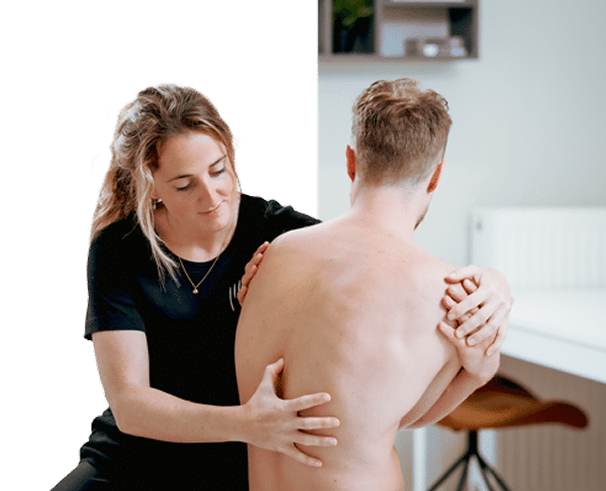What is the Achilles tendon
The Achilles tendon connects the calf muscles to the heel bone. The tendon absorbs high forces during push-off, jumping, and landing. Overload can lead to pain, stiffness, and sometimes thickening. In rare cases, a rupture may occur.
Recognizable symptoms
- Achilles tendon pain when getting up and morning stiffness
- Pain in the Achilles tendon while walking or after exercise
- Achilles tendon pain when running, especially after acceleration
- Thickening or lump on the Achilles tendon or a small bump on the tendon
- Sensitive Achilles tendon insertion low at the heel bone
- A sudden snapping sensation with immediate severe pain may indicate a rupture
Do you recognize this? Have your complaints assessed in time. Starting early speeds up recovery.
Causes and risk factors
The Achilles tendon reacts to repeated pulling forces. Rapid training build-up, frequent jumping, hills, and hard surfaces increase the load. Limited ankle mobility and tight calves also play a role. Changing shoes can trigger complaints. Sometimes there is bursitis near the heel. A strain can occur with an unexpected push-off. A rupture can happen during an explosive movement.
Insertion or mid-portion of the tendon
Complaints at the Achilles tendon insertion are felt low at the heel bone. This requires a different exercise approach than mid-portion complaints. Deep bending is often more sensitive at the insertion. In mid-portion issues, thickening higher in the tendon is more common.
What you can already do yourself
- Adjust your load and keep moving without sharp pain
- Start each morning with gentle ankle rolls and light calf exercises
- Apply heat to a stiff Achilles tendon after sleeping
- Choose shorter steps and a steady walking cadence
- Wear supportive shoes with a firm heel cap and cushioning
- If Achilles tendon pain worsens or persists, schedule an intake
These steps help improve Achilles tendon circulation and allow the tendon space to recover.
Examination and treatment plan at De Fysio Man
We listen to your story and goals. We test calf strength, ankle mobility, running technique, and footwear. We determine whether it concerns the insertion or the mid-portion and tailor the plan accordingly. You receive clear home programs and measurable milestones.
- Tendon-focused calf exercises progressing from isometric to eccentric to strength
- Mobilizations of ankle and kinetic chain plus technique advice for running and push-off
- Taping the Achilles tendon for short-term comfort where useful
- Possibly an Achilles tendon brace or insoles for clear alignment or shock absorption problems
- Achilles tendon massage may provide relaxation, but the core remains progressive loading
Rehabilitation by phase
Phase: reduce pain and stiffness
We start with pain-free exercises and clear pain limits for daily activities. Heat in the morning and short activations throughout the day help.
Phase: build strength and control
We increase the load with controlled calf exercises with both bent and straight knee. Ankle and hip are addressed for smooth and powerful movement.
Phase: return to walking and jogging
We systematically build up walking and light jogging. Achilles tendon pain while walking stays within safe limits. If the tendon reacts more stiffly the next morning, we adjust the schedule.
Phase: sport and plyometric exercises
We add pace, direction, and jump forms. You learn to dose load and recover. The goal is safe, confident sports without recurring Achilles tendon pain.
Strain, rupture, and surgery
With an Achilles tendon strain, fibers are overstretched. With a calm program, recovery takes weeks to a few months. In case of a partial Achilles tendon tear, examination and goals determine the treatment path. Sometimes conservative treatment with functional immobilization is possible. In case of a complete Achilles tendon rupture, surgery may be needed. We also guide the rehabilitation after Achilles tendon surgery. Terms such as torn Achilles tendon recovery, ruptured Achilles tendon recovery, and Achilles tendon tear recovery describe the same route with clear milestones. Also ask for advice about driving after an Achilles tendon tear. Safety comes first.
Prevention and avoiding relapse
Vary your training. Build up gradually. Maintain a short morning routine for mobility and activation. Replace worn-out shoes on time. Listen to early signals and adjust in time.
Frequently asked questions
Where is the Achilles tendon located?
At the back of your lower leg. The tendon runs from the calf to the heel bone just above the heel.
What to do with Achilles tendon pain when getting up?
Morning stiffness is typical in tendon complaints. Start with gentle ankle rolls and light calf exercises. If stiffness worsens, reduce your activity load from the day before.
Is a lump on the Achilles tendon worrying?
A thickening or small lump on the tendon is often an adaptation of the tendon. It is a signal to optimize load and technique. Sometimes tendon inflammation or bursitis is involved. We assess this and adjust your plan.
Do taping, braces, or insoles help?
They can provide comfort and temporary support. Real progress comes from tendon-focused training and proper loading.
Can I continue walking or running?
Yes, if the pain remains mild and recovers quickly. Achilles tendon pain while walking requires careful dosing. In running, we build up gradually. Pain during walking or running should be short and not worsen the next morning.
Your next step
Do not keep walking with pain. With a clear diagnosis and a smart plan, you will regain confidence in movement and sports.
Schedule an appointment at De Fysio Man now and work with us towards strong and resilient Achilles tendons.
Share this article:


